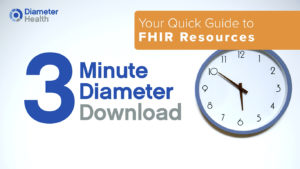While “FHIR” is the latest battle cry in healthcare IT circles, what does it really mean for payers and providers, and what are the future implications?
Over the past several weeks, Diameter Health released a series of short videos as part of the 3-Minute Diameter Download educational series. Think of these videos as a handy set of CliffsNotes® that summarize why FHIR matters, highlight the new federal regulations and requirements, and explain key aspects of the FHIR standard such as “resources.” We also cover the importance of ensuring good data quality when implementing FHIR-based solutions. This post summarizes key points made in the video series and includes a set of links to the videos for your reference.
FHIR (“Fast Healthcare Interoperability Resources”) represents a new standard for how healthcare data can be exchanged. FHIR is a language for health data that allows information to be shared and understood across different organizations and applications. FHIR enables data exchange using an application programming interface (API), which is how many internet and modern applications work. Unlike prior standards, FHIR dictates both how data should be transported and how that information should be structured.
FHIR regulations and timeline: Two rules concerning FHIR were finalized in March 2020 by the Office of the National Coordinator (ONC) for Health Information Technology and the U.S. Centers for Medicare and Medicaid Services (CMS). Effectively, these rules establish timelines for when payers must implement FHIR APIs that will enable member access to their health data.
The following are three key points on the FHIR timeline:
- In July 2021, CMS will require health plans to make cost and clinical data available to their members using the FHIR standard. This means members will be able to go to their health plans and download their health data to a phone or another device.
- Next, in 2022, health plans must be ready to share member data with other plans as members change insurers.
- Finally, providers will be required to use certified EHRs that support FHIR in 2022, although upgrades to EHRs may roll into 2023.
While these timelines are subject to delay, this should not be expected, and health plans must begin operationalizing these requirements sooner rather than later.
FHIR resources and profiles: FHIR was first conceived in 2011. A key concept in this early work was to break up clinical data into manageable parts. These manageable parts later became known as FHIR resources. For example, immunization is a FHIR resource that communicates when and how a vaccine was administered.
The idea is for these granular health data concepts to be used to convey data in isolation or grouped together to form more complex concepts. FHIR resources draw on data required by the federal adoption of EHRs and build off of existing data standards, such as the U.S. Core Data for Interoperability (USCDI). The USCDI covers 15 types of data, which are core to the information stored in medical records and span everything from narrative content like clinical notes to highly structured numeric information like vital signs.
FHIR is an international standard, which means that the resources themselves are relatively flexible, but are not robust enough to meet USCDI expectations for data. For example, a lab result that is recorded using FHIR must also contain some additional constraints to meet federal regulations. These constraints in FHIR are known as “profiles.” Examples of constraints within a profile that would make lab information from a FHIR resource suitable for USCDI include using LOINC (the primary terminology for lab activity in the U.S.), as well as listing status and time. By pairing FHIR resources and expectations for data as defined in profiles, healthcare organizations can begin utilizing more accurate and complete healthcare data.
Issues with data quality: In the real world, however, data often falls short of USCDI requirements. In data collected from various organizations, Diameter Health found that only 50% of lab information nationally is coded to appropriate standards. For example, HbA1c, which is a lab measure of glucose control among diabetics, the correct LOINC code and description are used only half the time. Instead, various alternative coding systems and textual descriptions are used to describe the same lab result. This is just one example of an industry-wide problem: unstructured, dirty data.
As organizations begin implementing FHIR standards to exchange clinical information and deliver health data to patients, they will encounter these types of dirty data episodes – and the consequences may be serious: Poor data quality will adversely affect member satisfaction and impede the use of healthcare data for analytics, population health, and quality measurement.
Better care requires better data. Normalizing and enriching healthcare data to meet national standards in real-time is Diameter Health’s core competency. To learn more, contact us.


